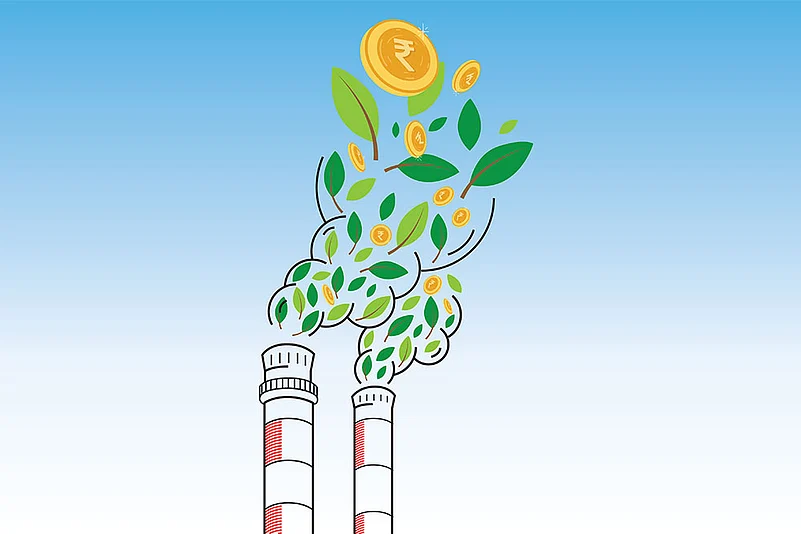Carbon trading is an important tool in global climate change mitigation efforts that incentivises the reduction of greenhouse gas emissions. Following up aggressively on its commitment to reduce carbon emissions by 1 billion tonnes by 2030, India is working on developing a robust carbon trading market. To this effect, two major developments are expected this year—release of the framework and the opening of the voluntary carbon trading market. The gains to be made from the carbon market are many, but is India Inc. ready for the challenges that come along with the opportunities?
Carbon markets, where carbon credits are sold and bought, can be either compliance-based or voluntary. Carbon trading is not new to India. Between 2010 and 2022, India exported 35.94 million carbon credits, or nearly 17% of all voluntary carbon market credits granted globally. But last year, the government decided to prohibit the companies from exporting their carbon credits until the country reaches its climate goals of reducing one billion tonnes of carbon emissions by 2030 and reaching net zero by 2070.
Close on the heels of the energy conservation act coming into effect in January this year, the Ministry of Power released the draft of the carbon credit trading scheme—aimed at establishing a framework for the carbon market in India—in March and invited suggestions and comments by April 14.
The proposed carbon credit trading system will be a component of the Indian Carbon Market (ICM) which is being developed by the Bureau of Energy Efficiency (BEE). ICM will encompass both voluntary and compliant carbon markets, according to the power ministry’s draft. The draft proposes to set up a carbon marketing governing board which will meet every quarter. The BEE will be the administrator and will, among other things, develop market stability for carbon credits.
The optimism is apparent. BEE director general Abhay Bakre had earlier said that India will be the biggest carbon market in the world by 2030. The wave to channelise the growth towards an environment-friendly sustainable pathway is expected to gain a significant push as the development of a domestic carbon market and the national emission trading scheme (ETS) gains momentum, according to Manish Dabkara, chief managing director and chief executive officer of Indore-based EKI Energy Services, a major carbon credit developer and supplier.

“Besides the regulatory ETS, India will soon have its own voluntary carbon market which will unlock new opportunities for Indian developers of carbon credits and also increase the demand for credits among Indian businesses and organisations with a renewed focus on greenhouse gas emission reduction and increased private sector participation in combating climate change,” says Dabkara.
According to Kishore Butani, head of program, policy and partnerships at Universal Carbon Registry—which tracks and verifies carbon emissions and issues carbon and water credits to green projects—this is just the beginning of India’s efforts to mitigate the impact of climate change in compliance with the guidelines outlined in the Paris Accord. The governments only have control and authority over the rules in a compliance market environment, he explains. “Sanctions, rewards and creative compliance pathways result in stable and non-volatile carbon prices that highlight a country’s commitment to a net-zero carbon footprint and ability to lead on climate change. A suitable example to emulate is the multi-billion-euro EU-backed compliance market, which was outlined in the BEE’s initial draft from last year,” he says.
“India’s compliance market could also cover about 500 to 1,000 obligated entities on a similar line, like EU ETS, with regards to industrial sectors with large carbon intensity footprints,” Butani adds. The key difference, he points out, is that India’s compliance market, as per the draft, is aimed at reducing carbon intensity (tCO2e/tonne of production), unlike all other international compliance markets which are based on cutting absolute emissions (tCO2e). “India’s per capita energy consumption is one-third of the world average. Similarly, our emission per capita is far below than world average,” he says, explaining that it makes sense for the country to take the emission efficiency route since it needs to provide the minimum basic energy access to its citizens.
According to Rohit Kumar Singh, health, safety and environment head, Eden Renewables India, the development will trigger a rise in credit demand among domestic Indian companies. “Since we are a green energy developer, everything we produce is completely converted to reduce carbon emissions; as a result, we aim to produce as much as we can with greater asset generation efficiency. For instance, we can generate 1.3 lakh carbon credits from a 10 mega watt project in Uttarakhand. We entirely alter technology to produce energy from natural resources using renewable energy sources, giving a 100% carbon offset compared to conventional carbon offsetting,” says Singh.
According to Decarbonising India: Charting a Pathway for Sustainable Growth report by Mckinsey, India has the potential to create 287 gigatons of carbon space for the world. This amounts to almost half of the global carbon budget for an even chance at limiting warming to 1.5°C. However, the current pace of emissions intensity reduction is insufficient for India’s emissions curve to bend with the expected growth outlook, the report adds.
An accelerated scenario, that entails adoption of new policies like carbon pricing as well as accelerated shift to sustainable consumption like electric vehicles, alternate materials, etc. faces a lot of challenges, but there are emerging tailwinds in the form of reducing costs of renewables and electric vehicles, and the progressive policies being implemented are helping the electrification of mobility, according to the report.

India stands to gain significantly from an orderly transition from thermal power to renewables, the report argues. The transition has the potential to help save a cumulative $1.7 trillion in foreign exchange—a sum that the government might otherwise spend on energy imports until 2070.
The carbon market will also open new vistas for businesses involved in developing, advising and trading carbon credits.
According to Jasmeet Singh Bajaj, director, Fair Climate Fund, India, the introduction of regulatory guidelines for the carbon market by the government is a positive development for the sector overall. The carbon credit trading mechanism will give all stakeholders, especially the international investor and carbon project developer, the much-needed transparency. Also, the rules of the carbon credit trading programme facilitate the development of the domestic Indian market.
Not Quite Simple
While there is a lot going for ICM, India will have to account for the challenges as well. A report titled Understanding Carbon Markets: Prospects for India and Stakeholder Perspectives, published by the Delhi-based Council on Energy, Environment and Water, a think tank and policy institution, highlights a lack of understanding around an ETS among Indian stakeholders, as they are more familiar and comfortable with the offset/project-based approach.
Nishtha Singh, programme associate, Council on Energy, Environment and Water, who had co-authored the report with Vaibhav Chaturvedi, says, “Indian companies have a decade-long experience with the Perform Achieve and Trade scheme. Therefore, they are much better prepared for an ETS than their counterparts were when ETS was launched in other countries. However, one challenge is that, due to the extensive experience in the offset market, there needs to be a sustained and deep engagement with the stakeholders for them to understand how a project-based system is different from an ETS and how they should be looked at differently.”

The report notes that the private sector-driven voluntary carbon market has been a driver of climate finance in India, with suppliers getting finance from domestic and international companies. However, in the ETS system, there will be just domestic trading. “The only way to ensure that there is a flow of foreign money to fund India’s mitigation actions is if India’s ETS is linked (as a seller) to global ETSs like the EU-ETS. In the absence of that, only the UNFCCC-based (e.g., Article 6-related carbon markets) or the voluntary actions-driven markets would be a source of international climate finance for Indian companies,” it states.
“There is a need to build a sustainable demand for carbon credit from local industries which are already under the pricing pressure. Conducive policies at the central level will help the local industries implement their decarbonisation strategy and be incentivised through the carbon trading market at the same time. The strategy of establishing carbon pricing is important and will ensure the long-term success of the carbon trading market,” Bajaj elaborates.
A regulated carbon trading market will need policy certainty. The government must communicate the ETS design, its decarbonisation strategy and the trajectory of an ETS’s emission caps at the earliest. “Policy certainty will help companies develop their decarbonisation strategies that can then prove beneficial in the longer term. For example, in Europe, industry stakeholders supported an ETS because they found the policy to be much more certain than other decarbonisation policies,” Nishtha Singh points out, adding that an ETS also needs robust structures for monitoring, reporting and verification (MRV), an effective penalty, and an effective cap and allowance allocation mechanism.
The Indian carbon market must align with the global standards. Failure to do so will affect its prospects in the international market, the Centre for Energy Regulation at Indian Institute of Technology, Kanpur, has said in its comments to the draft policy paper.
The CER has warned that in the absence of a demand, the carbon market will suffer from low liquidity, loss of competition and market efficiency. “Annualised Target setting, based on NDC [nationally determined contribution] commitments, and translating the same to the annual targets of the identified sectors/entities would be a very important task for market design,” it has stated.
The country will also need an accurate, transparent and effective monitoring, reporting and verification framework for an efficient market mechanism and compliance regime.
Considering India’s lofty net-zero goals announced at COP26, it makes sense that the national carbon credit market is getting a push from the government. The carbon market is not just one of the most effective tools for reducing emissions, but it also provides reasonably priced emission reductions. However, making it an effective tool will be a huge challenge for India as it tries to balance its green goals with its ambition to become a developed country by 2047.





























